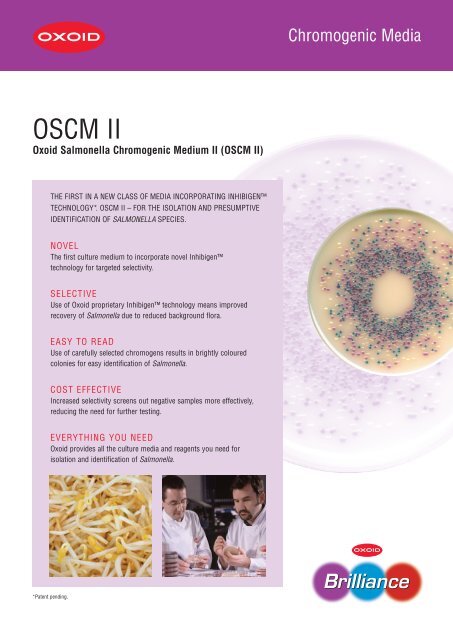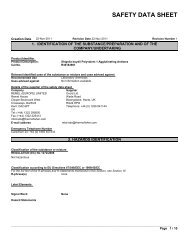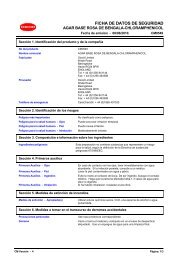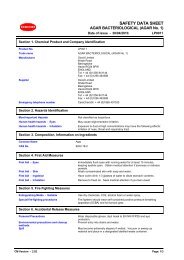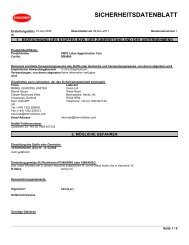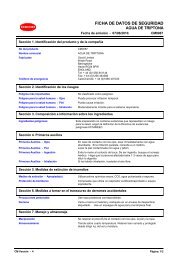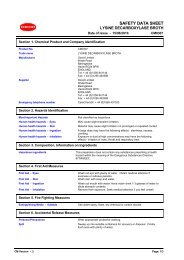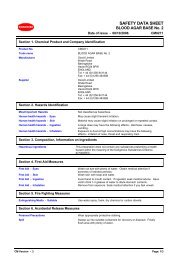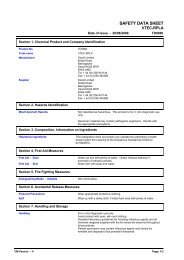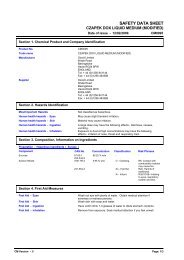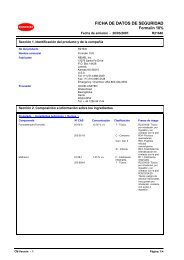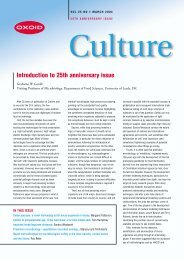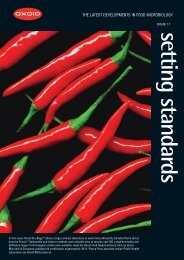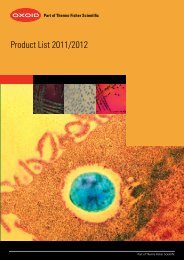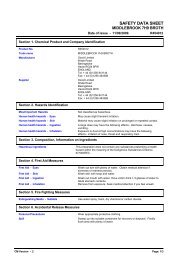OSCM II - Oxoid
OSCM II - Oxoid
OSCM II - Oxoid
You also want an ePaper? Increase the reach of your titles
YUMPU automatically turns print PDFs into web optimized ePapers that Google loves.
<strong>OSCM</strong> <strong>II</strong><br />
<strong>Oxoid</strong> Salmonella Chromogenic Medium <strong>II</strong> (<strong>OSCM</strong> <strong>II</strong>)<br />
THE FIRST IN A NEW CLASS OF MEDIA INCORPORATING INHIBIGEN<br />
TECHNOLOGY*. <strong>OSCM</strong> <strong>II</strong> – FOR THE ISOLATION AND PRESUMPTIVE<br />
IDENTIFICATION OF SALMONELLA SPECIES.<br />
NOVEL<br />
The first culture medium to incorporate novel Inhibigen<br />
technology for targeted selectivity.<br />
SELECTIVE<br />
Use of <strong>Oxoid</strong> proprietary Inhibigen technology means improved<br />
recovery of Salmonella due to reduced background flora.<br />
EASY TO READ<br />
Use of carefully selected chromogens results in brightly coloured<br />
colonies for easy identification of Salmonella.<br />
COST EFFECTIVE<br />
Increased selectivity screens out negative samples more effectively,<br />
reducing the need for further testing.<br />
EVERYTHING YOU NEED<br />
<strong>Oxoid</strong> provides all the culture media and reagents you need for<br />
isolation and identification of Salmonella.<br />
*Patent pending.<br />
Chromogenic Media
INTENDED USE<br />
<strong>Oxoid</strong> Salmonella Chromogenic Medium Mark <strong>II</strong> (<strong>OSCM</strong> <strong>II</strong>) is for the<br />
presumptive identification and differentiation of Salmonella species.<br />
SUMMARY<br />
<strong>OSCM</strong> <strong>II</strong> is a unique medium that combines the benefits of chromogenic media<br />
with new Inhibigen technology to reduce time to results over standard culture<br />
methods. Inhibigens are a new class of agent, developed by <strong>Oxoid</strong>, which can<br />
be used to target specific groups of organisms and prevent them from growing.<br />
In <strong>OSCM</strong> <strong>II</strong>, a specifically tailored Inhibigen is combined with other selective<br />
agents and the growth of non-target micro-organisms is significantly reduced.<br />
Carefully selected chromogens give excellent differentiation making it even easier<br />
to identify Salmonella and reduce the number of false positive colonies requiring<br />
confirmation.<br />
PRINCIPLES<br />
An Inhibigen compound comprises of two components combined together<br />
by a bond that can only be cleaved by specific enzymes. When bound, the<br />
inhibitor component is not toxic and therefore can exist in a medium without<br />
harming micro-organisms. Once inside the cell, the bond will be cleaved if the<br />
target enzyme is present. When the bond is cleaved, the inhibitor molecule is<br />
released, disrupting cell replication, resulting in targeted inhibition. As cells die<br />
and lyse, free inhibitor is released but cannot be taken up by other cells. The<br />
Inhibigen in <strong>OSCM</strong> <strong>II</strong> is used to specifically inhibit growth of Escherichia coli.<br />
Differentiation of Salmonella from any other organisms that are able grow on<br />
<strong>OSCM</strong> <strong>II</strong> is achieved through the inclusion of two chromogens in the medium:<br />
magenta-caprylate and X-ß-glucopyranoside. Caprylate esterase is an enzyme<br />
present in all samonellae and some species of Klebsiella, Enterobacter and<br />
Proteus1 . Organisms possessing caprylate esterase cleave the chromogen to<br />
release an insoluble purple chromophore. As the cells grow the chromophore<br />
builds up and produces a purple-coloured colony. Some Enterobacteriaceae<br />
including Klebsiella and Enterobacter, but not Salmonella, possess ßglucosidase,<br />
which means that they are capable of taking up and cleaving X-ßglucopyranoside2<br />
. If these organisms grow they will form blue or dark blue<br />
colonies, which make them easy to differentiate from purple Salmonella colonies<br />
even if they are esterase positive.<br />
Novobiocin and cefsulodin inhibit the growth of other competing flora such as<br />
Proteus spp. and pseudomonads.<br />
PRODUCT SIZE ORDER CODE<br />
<strong>OSCM</strong> <strong>II</strong> Base 108g (2 litres) CM1092E<br />
<strong>OSCM</strong> <strong>II</strong> Base 500g CM1092B<br />
Salmonella Selective Supplement 10 vials (each for 500ml) SR0194E<br />
<strong>OSCM</strong> <strong>II</strong> Plates 10 plates PO1118A/<br />
PO5098A*<br />
* Check codes and availability with your local <strong>Oxoid</strong> supplier.<br />
FORMULA<br />
PER LITRE<br />
Salmonella Growth Mix/Nutrient mix 14.0g<br />
Chromogenic Mix 25.0g<br />
Agar 15.0g<br />
Novobiocin 5.0mg<br />
Cefsulodin 12.0mg<br />
Final pH 7.3 ± 0.1 at 25ºC.<br />
500g of <strong>OSCM</strong> <strong>II</strong> Base will make 9.2 litres. Each litre of medium requires the<br />
addition of 2 vials of Salmonella Selective Supplement. Each box of supplement<br />
contains 10 vials.<br />
<strong>OSCM</strong> <strong>II</strong><br />
REFERENCES 1. Cooke. V.M. et al. A Novel Chromogenic Ester Agar Medium for Detection of Salmonellae. Appl. Environ. Microbiol. Feb 1999 p. 807-812, Vol. 65, No. 2. 2. Garrity, G., Brenner, D.J., Krieg, N.R.,<br />
Staley, J.R. (Eds.) Bergey’s Manual of Systematic Bacteriology. Vol 2, Part B. 2nd ed., 2005. US, Springer. 3. ISO 6579:2002 Microbiology of food and animal feeding stuffs – Horizontal method for the detection of<br />
Salmonella spp.<br />
DEDICATED TO MICROBIOLOGY<br />
DIRECTIONS<br />
Suspend 27 grams of <strong>OSCM</strong> <strong>II</strong> Base in 500ml of distilled water. Add the contents<br />
of 1 vial of Salmonella Selective Supplement, re-suspended as directed. Mix well<br />
and sterilise by bringing to the boil with frequent agitation. Cool to around 50°C,<br />
mix well and pour into sterile Petri dishes.<br />
NOTE: It is critical that the selective supplement is added prior to heating. When<br />
preparing volumes greater than 1 litre, contact <strong>Oxoid</strong> Technical Support for directions.<br />
METHOD OF USE<br />
<strong>OSCM</strong> <strong>II</strong> can be used for food, environmental and clinical samples, following a<br />
variety of enrichment procedures i.e. ISO, NMKL, FDA, HPA, etc.<br />
The following method is a summary of ISO 6579:20023 where a 2nd medium of<br />
choice may be used alongside XLD Agar:<br />
1. Add 25g of food sample to 225ml of Buffered Peptone Water and stomach for<br />
a minimum of 30 seconds to mix the sample.<br />
2. Incubate the broth at 37ºC for 18 h ± 2 h.<br />
3. Gently agitate the bag then, using a pipette, inoculate 1ml into 10ml of<br />
MKTTn Broth and 0.1ml into 10 ml of RVS Broth. Incubate MKTTn broth at<br />
37ºC for 24 h ± 3 h and RVS broth at 41.5ºC for 24 h ± 3 h.<br />
4. Using a microbiological loop sub-culture each broth onto one XLD Agar plate<br />
and one <strong>OSCM</strong> <strong>II</strong> plate to give a total of 4 plates.<br />
5. Incubate the plates at 37ºC for 24 h ± 3 h.<br />
6. Confirm presumptive red colonies with black centres from XLD and purple<br />
colonies from <strong>OSCM</strong> <strong>II</strong> as Salmonella species by appropriate biochemical and<br />
serological methods. Refer to ISO 6579:20023 .<br />
The following <strong>Oxoid</strong> products may be useful for confirmation: Nutrient Agar<br />
CM0003, TSI Agar CM0277, Urea Agar CM0053 & SR0020K, Lysine<br />
Decarboxylase Medium CM0403, Methyl-Red Voges-Proskauer (MRVP) Medium<br />
CM0043, Tryptone Soya Broth CM0129, Agglutinating Sera (see <strong>Oxoid</strong> product<br />
list for codes), <strong>Oxoid</strong> Salmonella Latex Test Kit DR1108A, Microbact (see <strong>Oxoid</strong><br />
product list for codes), O.B.I.S. Salmonella ID0570M.<br />
APPEARANCE, STORAGE & STABILITY<br />
Dehydrated Agar Base: white/cream coloured, free-flowing powder. Selective<br />
Supplement: white, freeze-dried pellet. Prepared Medium: white/cream coloured<br />
opaque gel.<br />
<strong>OSCM</strong> <strong>II</strong> Base should be stored tightly capped in the original container at 10-30ºC.<br />
Salmonella Selective Supplement should be stored in the dark at 2-8ºC. When<br />
stored as directed, the un-opened products will remain stable until the expiry<br />
date printed on the packaging. Store in-house prepared medium in the dark at<br />
2-8ºC for a validated period. <strong>OSCM</strong> <strong>II</strong> ready-to-use plates should be stored as<br />
indicated on the packaging.<br />
LIMITATIONS AND PRECAUTIONS<br />
With all Salmonella media there are a small number of atypical strains that may<br />
give a weak reaction or fail to grow.<br />
<strong>OSCM</strong> <strong>II</strong> Base and Salmonella Selective Supplements are for laboratory use only.<br />
Do not use <strong>OSCM</strong> <strong>II</strong> Base and Supplement beyond stated expiry dates, or if the<br />
products show any signs of deterioration. Material Safety Data Sheets and QC<br />
certificates are available on the <strong>Oxoid</strong> website www.oxoid.com<br />
QUALITY CONTROL TESTING<br />
ORGANISM CULTI-LOOPS ® TYPICAL COLONY<br />
ORDER CODE APPEARANCE<br />
Salmonella Typhimurium<br />
ATCC<br />
C6000L<br />
Good growth<br />
® 14028 † Purple colony<br />
Klebsiella pneumoniae<br />
ATCC<br />
C7037L<br />
Good growth<br />
® 13883 † Blue colony<br />
Enterococcus faecalis<br />
ATCC<br />
C7030L Inhibited<br />
® 29212 †<br />
Escherichia coli<br />
ATCC<br />
C7050L Inhibited<br />
® 25922 †<br />
www.oxoid.com<br />
<strong>Oxoid</strong>, Wade Road, Basingstoke, Hants, RG24 8PW, UK. Tel: +44 (0) 1256 841144 Fax: +44 (0) 1256 463388 Email: oxoid.food@thermofisher.com<br />
†The ATCC Licensed Derivative Emblem ® , the ATCC Licensed Derivative word mark ® , and the ATCC catalog marks are trademarks of ATCC.<br />
<strong>Oxoid</strong> Ltd is licensed to use these trademarks and sell products derived from ATCC ® cultures.<br />
© 2007, <strong>Oxoid</strong> Ltd.; copyrights to photographs held separately; contact <strong>Oxoid</strong> Ltd. for details. Photographs may not be extracted or reproduced in any way.<br />
Folio No: 1090/07/07


